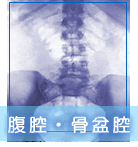|
 |
.Spleen laceration


 |
History :
This 34 years old gentleman had. Severe chest and abdominal pain since
traffic accident 2 days ago.
Image finding :
CXR revealed left lower rib fracture,abdominal CT revealed Gr. III
splenic laceration with fluid accumulation in peritoneal cavity.
Diagnosis :
1.Spleen laceration 2.Rib fracture
DISCUSSION :
SPLENIC TRAUMA
Most frequently injured intraperitoneal organ in blunt abdominal trauma
Associated with:
-other solid visceral / bowel injuries (29%); lower rib fractures
in 44%, injury to left kidney in 10%, injury to left diaphragm in
2% Technique:
-scanning delay of 60-70 sec to avoid the phase of heterogeneous splenic
enhancement
CT sensitivity:
->95% for splenic injury, but not reliable to determine need for
surgical intervention
-Attenuation of active extravasation (80-370 HU) exceeds that of splenic
parenchyma / clotted blood
Prognosis:
high PPV for surgery
1.Intrasplenic laceration linear parenchymal defect almost always
associated with hemoperitoneum
2.Splenic fracture laceration traverses two capsular surfaces
3.Subcapsular hematoma crescentic lesion along splenic margin flattening
/ indenting the normally convex lateral margin
4.Perisplenic hematoma "sentinel clot" (= area of >60
HU adjacent to spleen) sensitive predictor of splenic injury
5.Delayed splenic rupture =hemorrhage >48 hours after trauma --Prevalence:0.3-20%
of blunt splenic injuries
--Time of onset:in 70% within 2 weeks of injury, in 90% within 4 weeks
of injury
Rx:
52% surgery (splenectomy (8%), splenorrhaphy), 48% nonsurgical management |
|
 |
